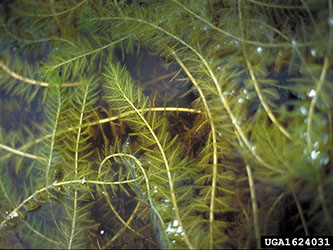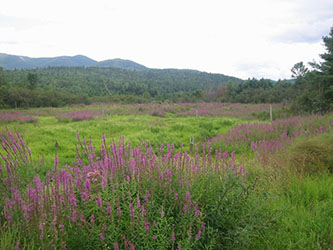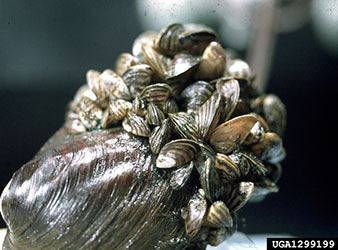By Lisa M. Genier – Adirondack Council Program Analyst
Monday, June 9, 2025
Today marks the beginning of New York’s Invasive Species Awareness Week. Let’s celebrate this week and learn how to help “Stop the Spread” all season long!
What you can do to celebrate Invasive Species Awareness Week
- Click here to discover what’s happening in your area this week
There are many activities around the state. - Familiarize yourself with invasive species
Some are pictured below, and unfortunately, you can find more here. - “Clean, Drain, and Dry”
Before moving between waterbodies, wash your boat and trailer at one of the free boat wash stations in the Adirondacks. Check live wells and bilge tanks for standing water. Once cleaned and drained, let it dry for at least 48 hours. - Don’t transport firewood
It might contain tree-killing pests – burn it where you buy it. - Check yourself and your pets
Terrestrial invasives can also latch onto clothing and gear, so brush your boots and clothes when you’re done for the day. Also, wash your gear regularly. If you hike with a four-legged friend, make sure to brush and bathe your pup to help prevent the spread. - Stay on the trail
In addition to being an important Leave No Trace principle, it limits the chance to pick up and spread seeds. - Report invasive species
The Adirondack Invasive Plant Program (APIPP) provides information so that you can view the locations of infestations and record your own sightings. - Use only native plants in your garden
Click here for more ideas on how you can help stop the spread!
As you can see, some invasives don’t look ominous. Some are even pretty. But beware…looks can be very deceiving.
 Emerald Ash Borer Agrilus planipennis Has a golden-green body with dark, metallic green wings and a purplish-red abdomen. Larvae feed on the bark tissue of native ash, effectively girdling the tree. Photo courtesy of APIPP |
 Eurasion Watermilfoil Myriophyllum spicatum Usually has four feathery leaves around the stem. Easily transported to and from waterbodies. Forms dense mats that degrade habitat and curtail recreation. Photo courtesy of APIPP |
 Garlic Mustard Alliaria petiolata A biennial herb that can grow multiple stems up to four feet tall. In May, white flowers grow at the top of the stems. Releases chemicals harmful to soil fungus, which is important to trees.Photo courtesy of APIPP |
 Giant Hogweed Heracleum mantegazzianum A biennial herb.Grows to 8-14 feet. Easiest time to identify is when it blooms in June. Caution – has sap that can cause severe skin irritation, blistering, and scarring. Photo courtesy of NYSDEC |
 Japanese Knotweed Fallopia japonica A fast-growing, perennial with jointed, hollow stems and alternate, oval, leathery leaves. White flowers bloom in August, and reddish stems are visible in winter. Photo courtesy of APIPP |
 Purple Loosestrife Lythrum salicaria A perennial that grows three to seven feet. Easily identified by its magenta flowers from July to September. Invades wetlands, altering their ecological structure and function. Photo courtesy of APIPP |
 Spiny Waterflea Bythotrephes cederstroemi Tiny crustaceans less than 1/2″ in size with sharp, barbed tails. Predators of small zooplankton, which is an important food for young fish. Reproduce rapidly. Eggs can lie dormant all winter.Photo courtesy of APIPP |
 Zebra Mussels Dreissena polymorpha Tiny, freshwater mollusks with light and dark brown stripes. Displace native species and attach to surfaces. They remove particles from the water, which affects the ecosystem. Photo courtesy of APIPP |
|


